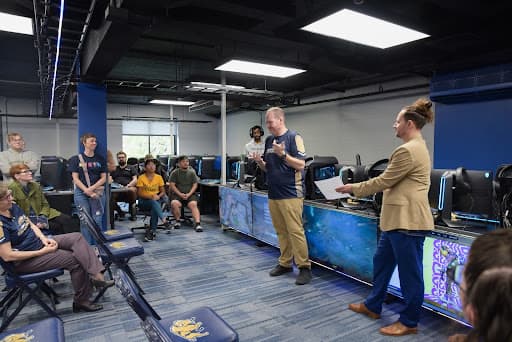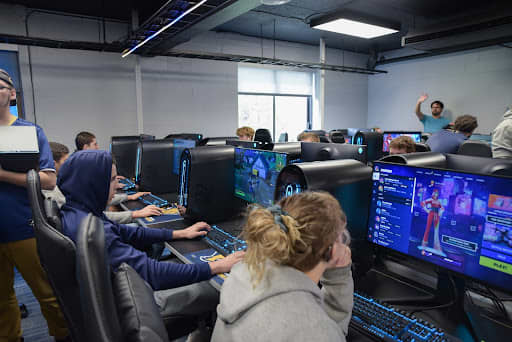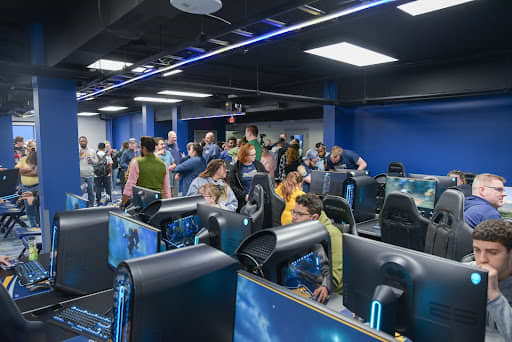Gallaudet University Opens Esports Arena Accommodating Deaf Athletes
 Credit: Image Courtesy of Justin Arrigo
Credit: Image Courtesy of Justin Arrigo- According to Gallaudet, the university has the first and only deaf-led collegiate esports program.
- The university cut the ribbon on its esports arena this spring.
- Prior to joining the Gallaudet faculty, coach Justin Arrigo helped start Gallaudet’s esports gaming club, and athletic director Warren Keller launched an online esports competition for deaf high school students.
In the spring, Gallaudet University, a private university for deaf and hard-of-hearing students in Washington, D.C., cut the ribbon on its esports arena.
According to Gallaudet, it offers the first and only deaf-led collegiate esports program and the first and only program that communicates primarily in American Sign Language. The arena is designed using DeafSpace principles — architectural guidelines Gallaudet pioneered to enhance accessibility for deaf people.
The DeafSpace gaming arena is 1,850 square feet of open space with a 350-square-foot private varsity practice room.
Athletic director Warren Keller and coach Justin Arrigo lead the program.
Arrigo tells people he was born with a controller in his hands. He helped found the Gamers United esports club (now Bison Games Club) during his education at Gallaudet.
Keller, who launched a worldwide online competition for deaf high school students, joined Gallaudet in January 2022 and began work on the esports arena.
He later hired Arrigo to coach and be the program coordinator.
“We’re very excited to lead the way and establish the standard on what Deaf gamers can achieve occupying the same space playing next to each other,” Arrigo told BestColleges.

“Obviously, our biggest disadvantage is not being able to hear at all and/or not being able to hear as well, and as a result, we rely heavily on our reaction time and mechanical skills, putting us a step above individually,” Arrigo said. “That, combined with peripheral vision and simple communication, will enable us to play at a higher level and at par with others.”
Gallaudet built the arena around DeafSpace principles, which helps Gallaudet gamers communicate clearly and without obstruction.
Arrigo said the biggest challenge deaf gamers face in hearing-designed environments is vision — when gamers can’t see each other’s screens or may not be close enough to enable simple communication between players.
Gallaudet’s DeafSpace arena fixes that.
Gamers have no line-of-sight obstructions besides a few support beams. The lighting is optimized so it doesn’t interfere with their eyesight, and there’s enough space to communicate in and out of gaming.
Desks with monitors, PCs, and video game consoles line the blue, gold, and white large open room. Fluorescent and RGB lights, usually lined across the floor or walls, line the ceiling rails.
“Esports really levels the playing field with organizations hard at work championing diversity, equity, and inclusion,” Arrigo told BestColleges. “Accessibility is our number one priority here at Gallaudet so we can all get our game on!”

What Is DeafSpace?
Gallaudet’s DeafSpace Project developed guidelines for architectural design that address five major touch points between deaf experiences and the environment.
Space and Proximity:
The space between two signers tends to be greater than spoken conversation. Signers stand at a distance to see facial expressions and the full “signing space.” The space increases with more people in the conversation.
Sensory Reach:
“Deaf people ‘read’ activities in their surroundings that may not be immediately apparent to many hearing people through an acute sensitivity towards visual and tactile cues,” according to the DeafSpace website. “These clues include vibrations, shadow movement, and reading subtle shifts in the expression of others.”

Mobility and Proximity:
Signers need a wider distance for clear visual communication while walking. Spaces must be designed with this in mind so deaf students can sense hazards and adjust accordingly.
Light and Color
“Poor lighting conditions such as glare, shadow patterns, and backlighting interrupt visual communication and are major contributors to the causes of eye fatigue that can lead to a loss of concentration and even physical exhaustion,” the website states. “Electric lighting and architectural elements used to control daylight can be adjusted to provide a soft, diffused light ‘attuned to deaf eyes.'”
Acoustics
Spaces also need to be designed to reduce background noise and excessive soundwave reflection. This is because assistive devices, like hearing aids or cochlear implants, are designed to enhance sound. To students using these devices, the noise can be distracting or even painful.